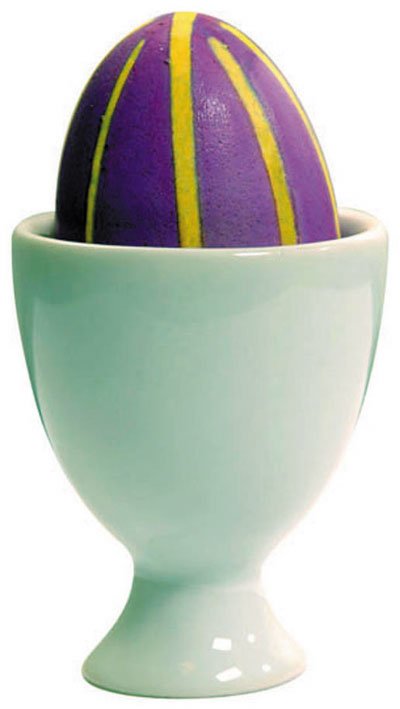The Paas dip ‘n’ dye harkens to the Easter rituals of childhood.
There’s something about carefully placing the dye tablets in the
bottom of each cup, adding a splash of vinegar, pouring in enough
boiling water to dissolve the dyes into rich, brilliant colors,
then balancing the eggs on those rickety wire dippers and lowering
them slowly into the liquid.
The Paas dip ‘n’ dye harkens to the Easter rituals of childhood. There’s something about carefully placing the dye tablets in the bottom of each cup, adding a splash of vinegar, pouring in enough boiling water to dissolve the dyes into rich, brilliant colors, then balancing the eggs on those rickety wire dippers and lowering them slowly into the liquid.
Some dyers opt for the all-natural route, using a wealth of material in their kitchens. Beets, spinach leaves, coffee, chili powder, turmeric, red cabbage and orange peel can all be used as dyes.
But why do we dye eggs? The Paas Web site notes eggs have been a symbol of fertility and life for thousands of years. Ancient Persians, Egyptians, Greeks and Romans exchanged colored eggs as a symbol of spring, the season of new life.
While the earliest dyes came from nature, and eggs have been dyed for thousands of years, the use of manufactured dyes have a long history as well.
According to Signature Brands, the company that now makes the Paas dyes, a druggist named William Townley began selling small packets of dye to neighborhood housewives in Newark, N.J., most of whom were of German descent but called Pennsylvania Dutch. In 1880, he launched a company called Townley’s Easter Egg Dye but soon changed the company’s name to Paas, from “pasen,” the Dutch word for Easter. Signature Brands says its products transform about 180 million eggs each year.
Whether you use a decorating kit or try to color naturally, it’s nice to know our egg dunking has historic significance. Here are a few suggestions for the dyeing days ahead.
THE HARD FACTS ABOUT EGGS
If you’re going to go through the bother of hard-cooking eggs for Easter dyeing, you might as well cook some extra for a variety of quick weeknight meals.
Hard-cooking up to 24 eggs at one time is probably the limit for a home cook to handle, at least according to experts such as the late Julia Child. That would give you a dozen eggs for dyeing and a dozen eggs for eating. (You can eat the dyed eggs, but make sure you keep them refrigerated.) Many supermarkets also feature cartons of 18 eggs during the Easter season, which can be more economical.
According to the American Egg Board, hard-cooked eggs in the shell can be refrigerated for up to one week. Hard-cooked eggs out of the shell should be used immediately.
What sort of egg to use depends on personal preference. And the choice goes beyond white or brown. There are a number of “all-natural” organic eggs on the market, and these are an especially appropriate choice if you’re using all-natural dyes.
If you find yourself with a fridge full of eggs, here are a few ways to serve them:
– Let hard-cooked eggs star on the hors d’oeuvre tray as deviled eggs – serve the split eggs dressed in dollops of mayonnaise and garnished with red pepper strips, an anchovy fillet or sliced olives.
– Many traditional Asian noodle soups feature a fresh-poached egg as a garnish. Why not replace it with a hard-cooked egg, cut into wedges or chopped?
– Eggs are a protein source; consider using them in place of meat or poultry.
HOW TO HARD-COOK EGGS
Hard-cooking eggs is easy; try these instructions from the American Egg Board (aeb.org):
– Place eggs in a single layer in a saucepan. Add enough tap water to come at least 1 inch above eggs.
– Cover pan; quickly heat just to a boil. Turn off heat.
– If necessary, remove pan from burner to prevent further boiling. Let eggs stand, covered, in the hot water about 15 minutes for large eggs (12 minutes for medium, 18 for extra-large).
n Immediately run cold water over eggs or place them in ice water until completely cooled.
– To remove shell, crackle it by tapping gently all over. Roll egg between hands to loosen shell. Peel, starting at the large end. Hold egg under running cold water or dip in bowl of water to help ease off shell.
– The American Egg Board recommends hard-cooking instead of hard-boiling eggs. Boiling eggs can make them tough and rubbery, and can create a slightly unappetizing (but entirely safe) green ring around yolk.
EGG DYEING IDEAS
You can use packaged kits or you can make your own dye with a few drops of food coloring mixed with a cup of warm water and 2 to 3 tsp.s of white vinegar.
The American Egg Board offers a few creative ideas for dyeing your eggs.
– Wrap rubber bands of different widths around an egg before you dip it in the dye to create a striped or plaid pattern, like the egg shown at left. Be sure to use rubber bands that fit snugly around the egg.
– Use a crayon or small candle to write a message or name on an egg before you dye it. The dye won’t stick to the wax of the crayon or candle.
– Hold a small leaf tightly against an egg and put them in a leg of a clean pair of nylon hose. Without moving the leaf, gently tighten the nylon against the eggshell and secure the ends of the hose with twist ties. Then dip the egg in the nylon in dye. Let the egg dry completely before you take it out of the nylon. The egg will be colored except for the spot where the leaf was.















